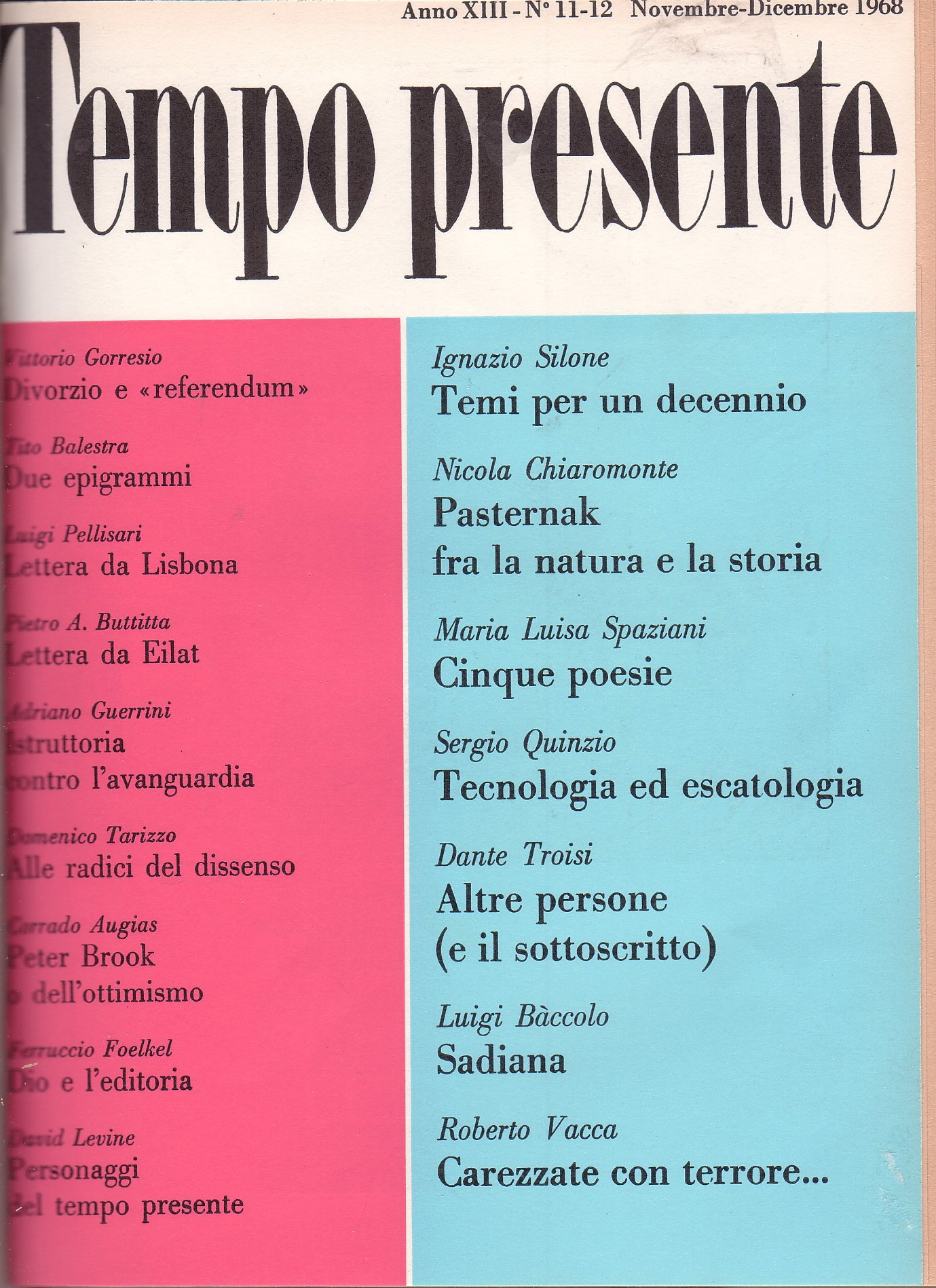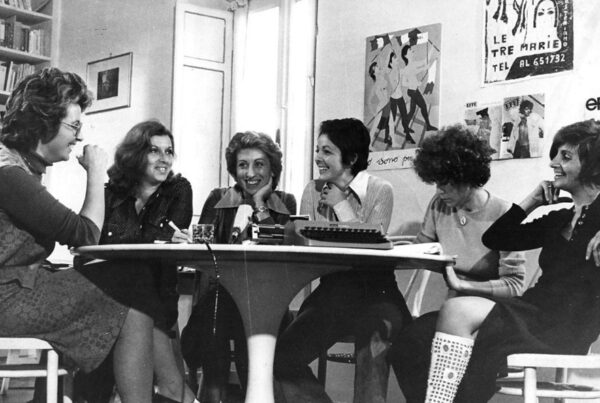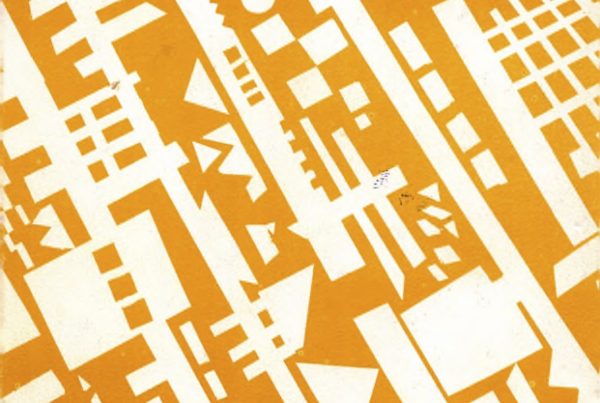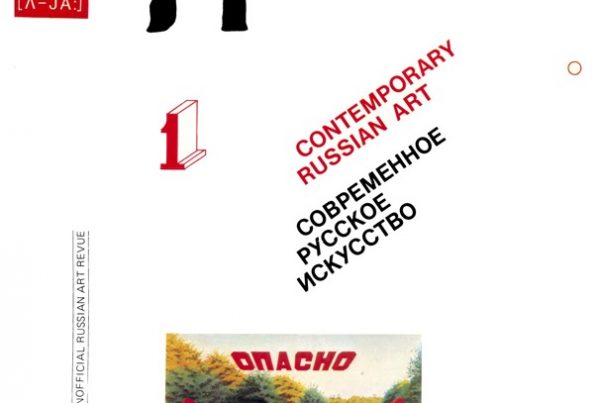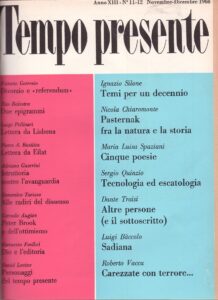
Cover n.11-12 year XIII, 1968. Source: https://www.lavocedinewyork.com/arts/libri/2017/10/20/silone-e-sciascia-verita/
Title of the magazine:
“Tempo presente” [Present time]
Dates: 1956–1968; 1980–still active (second edition)
Place of publication: Rome
Founders: Ignazio Silone, Nicola Chiaromonte
Total number of issues: 127 (1956 – 1968)
Principal contributors: Enzo Bettiza, Carlo Riccio, Enzo Forcella, Angelo Maria Ripellino, Alberto Ronchey, Gustaw Herling-Grudziński, Gleb Struve, Boris Pasternak, Andrei Siniavskii, Iulii Daniėl’, Ivan Anissimov, Isaiah Berlin.
Description:
“Tempo Presente” was first published from 1956 to 1968, and then from 1980 to the present day. The first series was especially important for the dissemination of alternative Russian literature and culture in Italy. The magazine was founded by Ignazio Silone and Nicola Chiaromonte with the aim of publishing cultural material from all over the world, including the Soviet Union. The founders were committed to the principles of freedom of expression and did not wish to promote any kind of ideology. An editorial statement on the first page, which, although unsigned, was certainly written by the two editors, emphasised their desire to instigate an exchange of ideas among people in as sincere a way as possible.
Thanks to its editor Luigi De Luca, the format of “Tempo Presente”, which was published monthly for a total of 11 annual issues (the issues of two months were combined) remained unchained. The magazine dealt with a wide range of subjects over the years, publishing articles by many Italian academics, and, largely thanks to the efforts of Chiaromonte became an important mouthpiece for writers and critics with different points of view (cf. Panizza 2017: 363-377). Critical essays and stories written by dissenting Soviet intellectuals were regularly published in the 1960s as well as articles by Italian scholars of Russian literature, translations of Russian short stories and articles on the events that characterised the years leading up to the Thaw and destalinization.
Gustaw Herling-Grudziński explores the phenomenon of the Thaw through the most important figures of the time, such as Abram Terts; while in 1961 the Jewish-American journalist Louis Fisher (cf. Fisher 1961: 599-602), and in 1962 the editor Nicola Chiaromonte (cf. Chiaromonte 1962: 67-68) also wrote about the apparently more liberal climate of Khrushchev’s early years. Also in 1962, the Hungarian journalist Tibor Méray violently attacked Khrushchëv from the pages of the magazine (cf. Méray 1962: 846-847). Enzo Bettiza’s column Diario di Mosca (Moscow Diary), appeared in many issues of “Tempo presente”, a space in which the writer discussed the ambiguity of destalinisation, which he considered an instrument used by the regime to mask its compromises and endless duplicities.
From 1958, the magazine became increasingly important in giving voice to Soviet dissent, publishing works by writers who could not publish in their own country. Significant space was given to the Pasternak affair with essays by Chiaromonte, the German journalist Gerd Ruge, Elémire Zolla and the critic Pietro Citati, among others, in defence of the writer and poet, victim of Soviet political repression. In December 1965, the magazine published an essay by Pasternak’s friend, Andrei Siniavskii entitled L’ultimo Pasternak (The Latest Pasternak) (cf. Sinjavskij 1965: 10-14), which illustrates the most recent literary activity of the writer.
“Tempo presente” closely followed the Siniavskii-Daniėl’ trial, which began in 1965. Sinyavsky had appeared on the cover of the magazine’s double issue for September-October 1959 which had published his short story, Si fa il processo (The Trial Begins) (cf. Sinjavskij 1959: 676-714), under the pseudonym Abram Terts, translated by Anjuta Maver Lo Gatto. The magazine also published the equally important essay, Che cos’è il realismo socialista (On Socialist Realism) (cf. ibid.: 715-736), translated by Venezio Smith which had already appeared anonymously in tamizdat in 1957 in Paris. In 1961 an essay by the Polish writer Gustaw Herling-Grudziński, editor of “Kultura” the tamizdat magazine of Polish emigrants in Paris, was published with the title Il processo continua (The Trial Continues) (cf. Herling 1961: 774-778) which linked the “Anonymous Soviet” author of What is Social Realism to the name Abram Terts, thus highlighting the importance of “Tempo Presente” in disseminating Siniavskii’s works.
Herling-Grudziński was a regular contributor to “Tempo Presente”, who wrote several essays for the magazine on the Thaw and the situation in the USSR, as well as a strenuous defence of Siniavskii and Daniel’ after the trial in 1966, which he defined as a “mock trial”.
Cecilia D’Ambrosi
[30th June 2021]
Translation by Cecilia D’Ambrosi
Bibliography
- Bettiza E., Diario di Mosca, Longanesi, Milano 1970.
- Chiaromonte N., Gazzetta. Intorno al XXII Congresso, “Tempo presente”, VII.1 (1962): 67-68.
- Fisher L., A che punto è la destalinizzazione?, “Tempo presente”, VI.8 (1961): 599-602.
- Guagnelli S., Tempo presente. Una rivista italiana cripto Tamizdat, “eSamizdat”, IX (2012): 87-104.
- Herling G., Il processo continua, “Tempo presente”, VI.11 (1961): 774-778.
- Méray T., Gazzetta. I neostaliniani e il disgelo, “Tempo presente”, VII.11 (1962): 846-847.
- Panizza C., “Tempo presente”, Nicola Chiaromonte, Ignazio Silone e l’Italia, in “Aspettando il Sessantotto. Continuità e fratture nelle culture politiche italiane dal 1956 al 1968”, Accademia University Press, Torino 2017: 363-377.
- Sinjavskij A., Società e letteratura in Russia. Si fa il processo, “Tempo presente”, IV.9-10 (1959): 676-714.
- Sinjavskij A. (Anonimo sovietico), Società e letteratura in Russia. Che cos’è il realismo socialista?, “Tempo presente”, IV.9-10 (1959): 715-736.
- Sinjavskij A., L’ultimo Pasternak, “Tempo presente”, X.12 (1965): 10-14.
To cite this article:
Cecilia D’Ambrosi, Tempo presente, in Voci libere in URSS. Letteratura, pensiero, arti indipendenti in Unione Sovietica e gli echi in Occidente (1953-1991), a cura di C. Pieralli, M. Sabbatini, Firenze University Press, Firenze 2021-, <vocilibereurss.fupress.net>.
eISBN 978-88-5518-463-2
© 2021 Author(s)
Content license: CC BY 4.0
